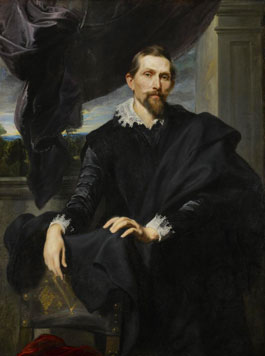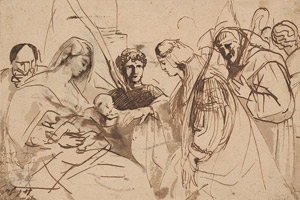The Status of the Baroque
John Haberin New York City
Anthony van Dyck: Portraits
Power and Grace: Flemish Baroque Drawings
For once, the Frick Collection attempts a blockbuster. Anthony van Dyck would not have had it any other way.
The most precious of small museums, the Frick manages two dozen paintings by van Dyck—on top of prints, oil sketches, and drawings. They take him from Antwerp to Italy, where the Baroque had only just begun almost exactly the year of his birth. They meet him in a dashing self-portrait at, at most, a remarkable fifteen years of age. They leave him with a portrait of Europe's leading art dealer clowning around with bagpipes in 1641, the year of his death barely into his forties.  They show him at home in the Flemish community in Genoa, a thriving port city, and triumphing as England's court painter for a decade. If this was the art world, I want to be a part of it.
They show him at home in the Flemish community in Genoa, a thriving port city, and triumphing as England's court painter for a decade. If this was the art world, I want to be a part of it.
van Dyck's portraits move easily among the exemplars of wealth, royalty, diplomacy, and religion. For him as for England, those were in fact inseparable, with almost any man in more than one role. They show him defining himself as an artist by creating an image for others. Yet they build after all on four portraits in the Frick, starting with those of another artist and his wife. They build, too, on his mentor, his compatriots, and his skill in drawing. "Power and Grace" at the Morgan Library compares works on paper by van Dyck, Peter Paul Rubens, and Jacob Jordaens.
That other artist with his wife is Frans Snyders, best known for scenes featuring animals, dead or alive. This is not the steady accumulation of paint and the foretaste of death in Dutch still life. No, Flemish art was far more assertive, in its aggressive brushwork and slick surfaces. So is Snyders in his portrait, with his hair, beard, and eyes equally alive, and one would hardly know that he is an artist. With one hand poised tautly on his lap and the other by his side, continuing the drama of a curtain tied to hang down directly above, he and his wife might just be boasting of their independent means. And so they were, for the portrait came on the occasion of their acquiring a country home.
The very image of spontaneity
Portraiture was like that for Anthony van Dyck, as an image of society unconcerned for mere detail—and an image of art concerned for everything. Signs of status appear casually, like a laurel or the sheer quality of dress. England's queen might be on a family outing, but she stands on a platform as on a stage, and that seeming child with a pet monkey on his back is a dwarf. The painter breaks through in 1623, with a cardinal in electric red, overlaid with a lighter fabric that could pass equally for gold or white. More often, though, color appears as a carefully chosen accent, not least in a person's cheeks. Snyders, like van Dyck himself in a commanding self-portrait at twenty-one, dresses in black.
He reveals little of himself, too, with nothing at all like self-portraits by Bartolomé Esteban Murillo at the Frick a year later. van Dyck paints his wife and, most likely, his mistress in almost the same pose and same blue dress shot through with white. Even their faces look much alike—and not only because of his taste in women. Yet they reveal how he thought and worked. He left the portrait of his mistress unfinished, and the drawings show how he began. He planned obsessively, but he also planned for frequent rethinking, and he left faces to work themselves out on canvas, as a focal point and the very image of spontaneity.
Like society, he thinks first of a pose, often played off against a standing column, and then of surfaces. On paper, he sticks mostly to black chalk, sometimes with highlights in white or, more rarely, red. They work out a pose, including the articulation of hands, with faces left to separate sheets or a blur. The Frick also includes Jacob Jordaens, the Flemish painter, and Peter Lely in England—both more reliant on washes and more concerned for finish. In Antwerp, van Dyck assisted Peter Paul Rubens, and both tackle the same theologian, a Jesuit who served in China. van Dyck has nothing of the older artist's insight into a brooding, grasping personality still capable of wisdom, but that leaves plenty of space for the theater.
Sometimes he takes next to oil on paper, in grisaille (or monochrome), to work things out further. Only then come canvas and the face—with background color or landscape last, if at all. Still, he works fast every step of the way, with a shadow or cloud almost like a halo. This is not Brian Wilson in his room gorging on Oreos instead of making music, for all their shared obsessiveness. A sitter spoke, half bemused and half complaining, of enduring sessions over six days. You can bet they were short sessions.
The curators, Stijn Alsteens and Adam Eaker, call the show "The Anatomy of Portraiture"—but anatomy is the least of its concerns, along with narrative. Even a Holy Family looks more like a family portrait than a vision. That teen self-portrait has a greater impasto, while a still earlier portrait draws on Tintoretto, the Venetian Mannerist with loose brushwork, sober faces, and ghostly light. All that quickly vanishes, as van Dyck does everything to hide his traces. While the cardinal's robe is a tour de force of red upon red, one cannot pin down a single fold. Still, the painter is by no means done, and he converts selected portraits into a compendium of stiffer prints, the Iconographie.
Like Frans Hals in the Netherlands or Diego Velázquez in Spain, van Dyck set the standard for the Baroque portrait, but without their penetration and reserve. Maybe he never does let his flowing hair down, no more than John Singer Sargent nearly four hundred years later. Yet he looks ahead to Sargent among friends, in drawings that set aside the aristocracy for such fellow artists as Adriaen Brouwer, Orazio Gentileschi, and Pieter Bruegel the Younger. A luxuriant but vulnerable red-haired woman even approaches Jo the Irish Girl by James McNeill Whistler in 1866. For once, the most class-conscious of artists allows his sitter to cut class.
Scattered bodies
"God is already famous," said Paul Bocuse, "but that doesn't stop the preacher from ringing the church bells every morning." The late French chef was not above promoting his vast influence, no more than the deity—to judge by a color sketch by Peter Paul Rubens of a village sermon. And it worked, for all eyes turn in rapture to the pulpit at upper right, where a fat and less than charismatic preacher looks about as marginal as his position on paper. Meanwhile an aisle draws the eye into depth, past two restless dogs, to where a lone face looks away. Although clean shaven, it might be Rubens himself, questioning for once his own orthodoxy and fervor. His skepticism adds an additional double note to "Power and Grace," Flemish Baroque drawings at the Morgan Library.
 The Morgan borrows that sketch from the Met, but the rest draws almost entirely on its collection. Rubens commands the center, between facing walls for Anthony van Dyck and Jacob Jordaens to either side, as makes sense for the master's greatest pupil and an artist some twenty years younger than both. van Dyck appears as the consummate observer, ever attentive to surfaces. The highlights on a dead Christ all but dematerialize him, even as the light itself seems to weigh him down. A rare landscape bears the date on which van Dyck saw the hill town, its distance marked by crossing branches in the foreground. He takes note of the observer, too, lending the greatest weight to a witness at the mystic marriage of Saint Catherine, in darker ink and wash at the drawing's center.
The Morgan borrows that sketch from the Met, but the rest draws almost entirely on its collection. Rubens commands the center, between facing walls for Anthony van Dyck and Jacob Jordaens to either side, as makes sense for the master's greatest pupil and an artist some twenty years younger than both. van Dyck appears as the consummate observer, ever attentive to surfaces. The highlights on a dead Christ all but dematerialize him, even as the light itself seems to weigh him down. A rare landscape bears the date on which van Dyck saw the hill town, its distance marked by crossing branches in the foreground. He takes note of the observer, too, lending the greatest weight to a witness at the mystic marriage of Saint Catherine, in darker ink and wash at the drawing's center.
Jordaens has harsher colors and stiffer figures. Religious and genre scenes alike fall between sentiment and caricature. A mother shows her tenderness even as she and her daughter raise anxious eyes toward the unknown. The artist lends his own features to a peasant stuffing his face with only modest encouragement from a satyr. The woman in an allegory of vanity seems to have every right to scorn the men bringing her a skull. Jesus commands attention in Christ Among the Doctors, but three tiers of figures and the architecture afford him a worthy niche.
The show takes its title from Rubens himself, as he articulated his aims. He studies the leg muscles of, no doubt, a corpse, but he allows them the power and dignity to stand erect. A third leg gives Rubens another chance to get it right, but also another chance for his subject to bear weight. Angels blowing trumpets flex their arms and legs, too, not to mention their lips and cheeks. Yet they seem no less graceful and lithe, as they fit neatly into niches to either side of a broad arch. They would have served as models for carvings in an Antwerp cathedral.
Daniel in the lion's den is even more impressive without the lions. A study isolates a young male model and brings him forward, seemingly within reach. One knee breaks the picture plane, while Daniel raises his clasped hands in front of his neck. Darker or doubled strokes of black chalk accentuate their irregular outlines and musculature. Lighter and longer strokes define wisps of hair for his head thrown back in prayer. His stability adds to the sense of motion and strength to prayer.
Many more Rubens drawings came to the Met in 2005. One could see him working his way out of Mannerism, so that studies like these could become more active and less cluttered. Rubens hardly needs the touches of white chalk to bring them fully into three dimensions. The trumpeting angels could be calling the corpse to life, much like the trumpets "at the round earth's imagined corners" in a sonnet by a near contemporary in England, John Donne: "arise, arise / From death, you numberless infinities of souls, and / To your scattered bodies go." Go, that is, with power and grace.

Portraits by Anthony van Dyck ran at The Frick Collection through June 5, 2016, Flemish Baroque drawings at the Morgan Library through April 29, 2018.




